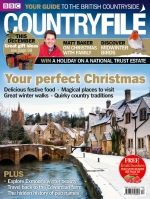The easy way to bake bread
Mon, 04/10/2010 - 11:56
In Countryfile Magazine’s endless quest to understand more about how our food is produced, I jumped at the chance to learn how to bake bread.
My teacher was master baker Jane Mason but when I turned up at her London flat on the River Thames in Hammersmith last month, I discovered my baking lesson would be part of a competition.
We would be testing 7 different types of flour, each from a different miller. Six had been ground using water or wind power by small, independent millers, while the seventh was from a supermarket from one of the country’s largest industrial millers.
Jane is passionate about eating well and knowing where our food comes from. Her website Virtuous Bread is a great resource for learning about what makes delicious bread – not only how you can make it, but also the history of breadmaking and how modern bread production can be more sustainable while also more healthy.
But back to the bake-off. First we compared the flours – each has a different colour and texture, some coarse, others sandy. They smelled different – some were rich and malty, others sour. And they also produced distinct loaves.
We used a very basic recipe for making a small loaf
- 300g of flour
- 200ml of water
- 5g of salt
- one sachet of baking yeast
- You need a half sized tin for this recipe or you could put the dough on a baking tray free-form.
You mix everything together then knead it. Kneading is something I’ve always dreaded with bread making – arm-aching dough violence with no visible results. But Jane was immensely encouraging, telling me to add more water than I’d normally expect so the dough was sticky and easier to manipulate. After 10 minutes, it was ready – or so Jane said.
We then tasted the raw dough to compare the flours. Again, the variety of flavour was striking. We let each dough ball rise for 30 mins or so, then flattened it, shaped it and popped it into a baking tin.
After 40 mins in the oven at 200°C, the loaves looked remarkably good (though the ones I’d shaped had a certain rustic charm compared to Jane’s more attractive, professionally fashioned creations).
Then it was the taste-off. The range of flavours and textures was astonishing, showing that different flours have varied properties. Our favourite was loaf made from flour from a watermill – and the blandest was the supermarket flour (but even that was delicious to a novice like me). You can find out the results here
We ate a fabulous simple lunch of bread, cheese and salami, with a couple of cucumbers from Jane’s unofficial allotment (a flowerbed that she has requisitioned).
Best of all, it was an extremely easy and extremely cheap way to put delicious bread on the table. All you need is time, a bit of patience – and not mind getting up to your elbows in dough.
Thanks to Jane for teaching me a new skill and for the inspiring conversation. I’ll be making bread every weekend from now on.





